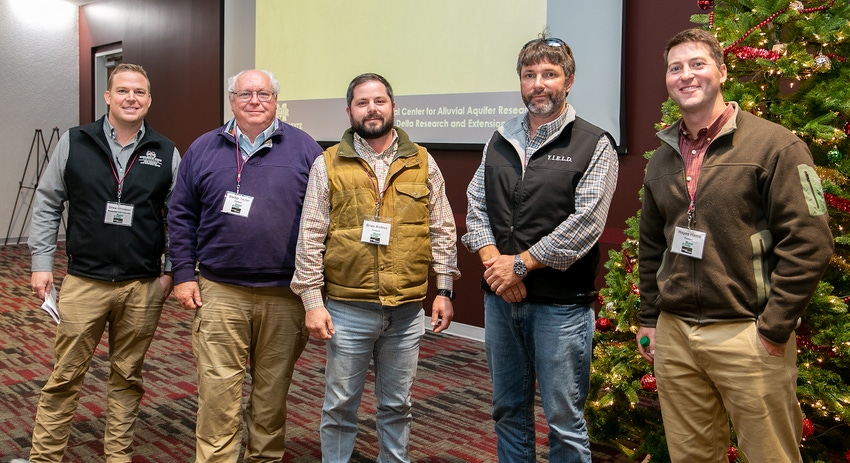
After a one-year hiatus, the popular Row Crops Short Course, hosted by Mississippi State University welcomed a large crowd in December. The three-day program featured research presentations from university scientists and farmers from across the region. Organizers estimate more than 500 people were in attendance.
Resistance management for both weeds and insects was a recurring theme. Researchers shared data on the performance of ThryvOn Cotton technology in university trials. A producer panel discussed the pros and cons of soil moisture sensors (spoiler: there were only pros). Below are a few takeaways from the meeting.
Researchers still big on ThryvOn
ThryvOn was put to the test in 2021 with extreme pest pressure in many parts of the Midsouth. University experts are still pleased with ThryvOn efficacy with thrips management.
“We did not see any ThryvOn cotton that would have reached the threshold for foliar treatment for thrips even in situations with very high thrips pressure,” said Whitney Crow, entomologist with MSU, speaking during a Short Course session. “It is very good on thrips.”
Things get more complicated when discussing ThryvOn’s tarnished plant bug management efficacy, although plant bug management has never been a primary feature of the technology.
“For plant bugs the best feature of this technology is that it will give us more time to react,” said Angus Catchot, entomologist with MSU. “The way we manage this cotton is going to be different.”

How will ThryvOn affect the bottom line? According to research presented during the program, it could potentially save on average 1 to 2 sprays for tarnished plant bugs per year in Tennessee and three plant bug sprays annually in Mississippi. It should eliminate the need to spray for thrips. Other advantages include not having to use harsh chemicals early and convenience, especially for smaller farms.
“ThryvOn really shines in the Mississippi hill country,” said Catchot.
ThryvOn will not be commercially available in 2022, but Bayer is planning to expand its Groundbreakers program, which uses farmers to trial the technology on larger acres. A suggested price for ThryvOn cotton should be released later this year.
Resistance issues continue
“Pretty disheartening” is how Larry Steckel, Extension weed specialist with University of Tennessee, described weed control outlook in his state. He has documented dicamba-resistant Pamer amaranth and waterhemp populations. That makes nine and eight modes of action, respectively, to which these weeds have developed resistance in Tennessee. Steckel said he fears glufosinate resistance could be forthcoming in his state.
As Steckel shared during his Short Course presentation, Tennessee may be ahead of the curve on dicamba resistance due to the large number of no-till acres and states farmers’ historical use of the herbicide for burndown, but other states are facing these similar weed resistance problems.
“2022 is shaping up to be a stressful year for weed management. Number one due to supply chain issues. Best I’m hearing we’re only going to have close to 80% of two critical herbicides we use: Roundup and Liberty. With that in mind we have to think of some alternatives.”
For Roundup substitutions, Steckel recommended considering a clethodim product. For example, a pint of 2-lb clethodim tankmixed with dicamba, should address grass weed control.
“From a Liberty standpoint, we don’t have a good substitute. Overlaying residual herbicides is going to be our best bet. Not having many weeds up that dicamba and Liberty have to control,” he said.
“In cotton, there are producers experimenting with coating fertilizer with pyroxasulfone and putting on cotton at V6 to V10 stage to get that last overlapping residual on,” he added. “I think we’re going to have to start thinking outside of the box.
Soil moisture sensors a good investment
A producer panel featuring four Mississippi growers (Brian Andrus, Hayes Harris, Jeffry Mitchell and Sledge Taylor) discussed their experiences with soil moisture sensors during Day 2 of the Short Course. All producers were overwhelmingly in favor of the technology with each citing examples of cost and time savings.
“The hardest part is learning to trust the technology,” said Mitchell. “But our records show that not only are we saving time and money, but our yields are up.”
Taylor also discussed the importance of soil moisture sensors from a conservation standpoint.
“Over the past 40 years farmers in the Mississippi Delta have put in more than 20,000 irrigation wells,” Taylor said. “There is exponentially more irrigation taking place these days. Anything we can do to conserve that resource will be beneficial to the future of agriculture in our region.”
About the Author(s)
You May Also Like






